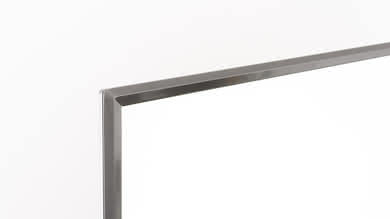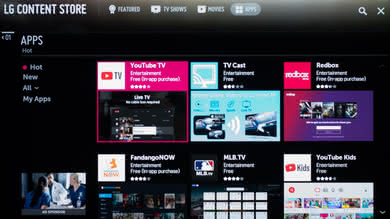The LG UK6570PUB is a good 4k IPS TV with wide viewing angles and outstanding low input lag, the best we've tested so far on a TV. It has excellent gradient handling and a fast response time. It has excellent reflection handling and good SDR brightness, good for daytime viewing. Unfortunately, it doesn't perform well in a dark room, since it can't produce deep blacks and has poor black uniformity. It also isn't great for HDR, as it isn't very bright in HDR and lacks a wide color gamut.
Our Verdict
The LG 75UK6570 is a good TV for most uses. It is well suited for gaming in SDR or watching TV shows and sports during the day. Unfortunately, dark room performance might be disappointing to some people, and although it supports HDR, there is little benefit to it as it lacks a wide color gamut and isn't very bright in HDR. The wide viewing angles, low input lag, and chroma 4:4:4 support make it a great choice for a computer monitor.
-
Image remains accurate when viewed at an angle
-
Excellent low input lag
-
Disappointing dark room performance
-
HDR performance is lacking
The LG UK6570PUB is a mediocre TV for watching movies in a dark room. It has a decent contrast ratio, but inadequate black uniformity, so blacks appear gray in a dark room. It also lacks a local dimming feature. It is able to remove judder from true 24p sources like a Blu-ray player, but not when they are being played from a cable box that embeds the movie in a 60p signal.
This is a very good TV for watching TV Shows during the day. It has good peak brightness in SDR and excellent reflection handling, and the wide viewing angles make it great for watching TV while doing chores around the house. Older sub-1080p content is displayed well, as the UK6570 doesn't use an RGBW sub-pixel arrangement.
Good TV for watching sports. It has a fast response time, but there is a short blur trail behind fast moving objects. It also has mediocre gray uniformity, and there is noticeable DSE that may bother some people. It is bright enough in SDR for most rooms, and has excellent reflection handling. It also has wide viewing angles, great for watching a game with a group of friends.
This TV is great for playing video games. It has the lowest input lag we've measured on a TV, great for even the most competitive gamers. It has a fast response time, so motion is clear with only a short blur-trail, but the 120 Hz PWM flicker may bother some people and causes duplications. It supports most common input resolutions, but it doesn't support 1440p or 120 Hz.
The TV is only mediocre for watching movies in HDR. Unfortunately, it can't get very bright in HDR and doesn't have a wide color gamut. It also has only decent contrast and disappointing black uniformity, so dark room performance is disappointing. It also lacks a local dimming feature.
This TV is good for HDR gaming. It has outstanding low input lag, with a fast response time, so motion looks clear and games are responsive. Unfortunately, HDR doesn't add much, as it doesn't have a wide color gamut and isn't very bright in HDR. It also doesn't perform very well in a dark room, as it has only decent contrast, disappointing black uniformity, and lacks a local dimming feature.
The UK6570 is a very good TV for use as a PC monitor. It has outstanding low input lag, ensuring a responsive experience. Chroma 4:4:4 is displayed perfectly, so text looks clear, and it has wide viewing angles, so the sides of the screen remain accurate when sitting fairly close to the TV. It also has a fast response time, so motion looks clear, and there is no risk of temporary image retention or permanent burn-in.
- 6.9 Mixed Usage
- 6.0 Movies
- 7.8 TV Shows
- 7.4 Sports
- 7.5 Video Games
- 5.8 HDR Movies
- 6.9 HDR Gaming
- 7.9 PC Monitor
Changelog
- Updated May 21, 2020: Converted to Test Bench 1.5.
- Updated Feb 21, 2020: Converted to Test Bench 1.4.
- Updated Feb 28, 2019: Converted to Test Bench 1.3.
- Updated Oct 09, 2018: Review published.
- Updated Oct 07, 2018: Our testers have started testing this product.
Check Price
Differences Between Sizes And Variants
We tested the 75" UK6570 (75UK6570PUB) and for the most part, we expect our review to be valid for the 86" UK6570 (86UK6570PUB).
The 70" variant (70UK6570PUB) has a VA panel, and we expect it to have a better native contrast ratio, but worse viewing angles.
If someone comes across a different type of panel or if their LG UK6570 doesn't correspond to our review, let us know and we will update the review. Note that some tests such as the gray uniformity may vary between individual units.
| Size | US Model | EU Model | Panel Type | Refresh Rate | Other Notes |
| 43" | 43UK6500AUA | 43UK6500PLA | IPS | 60 | |
| 50" | 50UK6500AUA | 50UK6500PLA | VA | 60 | |
| 55" | 55UK6500AUA | 55UK6500PLA | IPS | 60 | |
| 65" | 65UK6500AUA | 65UK6500PLA | IPS | 60 | |
| 70" | 70UK6570PUB | N/A | VA | 60 | |
| 75" | 75UK6570PUB | 75UK6500PLA | IPS | 60 | |
| 86" | 86UK6570PUB | 86UK6500PLA | IPS | 120 | - α7 processor |
The 75UK6570 we reviewed was manufactured in June 2018
Update 10/25/2018: The 43" UK6500 was incorrectly listed as having a VA panel, it has an IPS panel.
Compared To Other TVs

The 75UK6570 is a good TV for most uses. It is aggressively priced, and beats most of the competition in the same price range. See our recommendations for the best 75 inch TVs.
The LG UK6570 is much better than the LG UK6300. The UK6570 is much brighter with SDR content and has better color volume. The UK6570 has better motion handling, thanks to the faster response time. Finally, native 4k content looks better on the UK6570 since it doesn't use the less accurate RGBW sub-pixel structure found on the UK6300.
Overall, the Vizio E Series 2018 and LG UK6570 are very similar. The Vizio E Series 2018 has a VA panel and is better suited for dark room viewing sitting directly in front. The LG UK6570 has an IPS panel and is better suited for a bright room with side seating. The UK6570 has an optional motion interpolation feature, great for fans of the soap opera effect. The LG also has lower input lag, great for gaming or use as a PC monitor.
The Sony X850F and the LG UK6570 are very similar overall. The X850F is brighter in SDR and HDR and has a wide color gamut. The X850F has better overall motion handling, with slightly faster response time, nearly flicker-free backlight, and better motion interpolation thanks to the 120 Hz panel. The LG UK6570 has much lower input lag, great for gaming or use as a PC monitor. The 85" X850F uses a VA panel, compared to the 86" UK6570 that has an IPS panel, so the XBR85X850F likely will perform better in a dark room.
The LG UK6570 is a bit better than the Samsung NU6900 unless dark room performance is important. The UK6570 has wider viewing angles than the NU6900 and better reflection handling, making it a better choice for bright rooms with lots of side seating. The UK6570 has a faster response time, so motion looks clearer with less blur trail. The NU6900 has a VA panel and is better suited for a dark room with no side seating.
These are two different types of TVs, so if you have a room with wide seating arrangement, then the LG UK6570 might be better due to the wide viewing angles. On the other hand, in a darker room, the blacks of the Samsung NU7100 are deeper and enhance the picture quality provided you sit straight in front. In terms of less critical differences, the LG UK6570 can handle reflections better and has a crisper image due to the faster response time.
These two TVs are very different. However, most people will agree that the Samsung NU8000 is much better than the LG UK6570 overall. The LG has an IPS panel and is more suitable for a room with a wide seating arrangement, thanks to its better viewing angles. The Samsung, on the other hand, has better dark room performance, provided you sit right in front. The Samsung NU8000 can also get brighter to fight glare and has a few gaming goodies like FreeSync support and auto low latency.
The Samsung RU7100 and the LG UK6570 are very similar overall, but they use different panel types, each with their strengths and weaknesses. The RU7100 uses a VA panel and has much better dark room performance, thanks to the excellent contrast ratio. The UK6570, on the other hand, except for the 70" size, uses an IPS panel. This results in worse dark room performance, but much better viewing angles. Beyond these panel differences, the UK6570 can remove judder from 24p sources, and it has better reflection handling.
The LG UM8070 and the LG UK6570 have different panels, each with advantages and disadvantages. The UM8070 has a VA panel that delivers better dark room performance thanks to its higher contrast ratio and better black uniformity. The UK6570 has an IPS panel with wider viewing angles and favors watching TV from the side. The UK6570 can handle reflections better, but the response time on the UM8070 is faster and thus motion looks crisper on the UM8070. The LG UM8070 has an IPS panel and the differences with the UK6570 should be less apparent in that respect.
Test Results
The LG UK6570PUB has a great design. The stand holds the TV well, but it does wobble a bit if nudged and the stand is nearly the full width of the TV, so you'll need a big desk if you aren't planning on VESA mounting it. The back of the TV is one large metal panel, and while it isn't loose, it doesn't seem very solid and may dent easily. The overall build quality is good, and there shouldn't be any issues with it.
The back of the LG 75UK6570PUB is very plain. There is a single, large metal panel covering the entire back of the TV. No thought was given to cable management, there is only a single plastic cable tie included in the box.
The borders are thicker than some similar models, including the UK7700. There is a small gap between the outer panel and the display, but this isn't really noticeable under normal viewing conditions.
The LG UK6570PUB has good build quality. There are no issues with most of the TV, but the back panel is a single sheet of thin metal that may dent easily. Overall, it is very similar to the UK7700.
The TV has a decent contrast ratio, worse than most VA panels but above average for an IPS. Unfortunately, there is no local dimming feature to improve the contrast ratio.
Note: the 70" model has a VA panel, and will likely have a better contrast ratio.
The TV does not have a local dimming feature. The above video is provided for reference only.
The LG UK6570 has good peak brightness in SDR. The brightness hardly changes at all with different content, which is great. The real scene brightness is a bit dimmer due to the TV's uniformity.
Mediocre HDR brightness. Small highlights in some scenes aren't very bright, but large bright scenes are displayed at the TV's maximum brightness. There is some variation in brightness depending on content, which can be distracting.
If you find HDR content too dim, take a look at our recommended HDR settings.
The LG 75UK6570PUB has mediocre viewing angles, similar to the UK6300. The contrast stays relatively flat regardless of viewing angle, which is typical for IPS panels. Colors lose accuracy and the brightness drops at a small angle.
Note: the 70" model has a VA panel and is expected to have worse viewing angles.
Out of the box, the TV is one of the most accurate displays we have tested. White balance dE and color dE are very low, and the color temperature is only slightly cool. The average gamma is close to our target of 2.2, but fluctuates depending on the input, so some scenes are overly bright and some are overly dark. Most people won't feel the need to have the TV professionally calibrated.
4k content is displayed perfectly without any issues. Unlike the UK6300, the UK6570PUB does not use the less accurate RGBW pixel structure.
The TV has a decent color gamut, but it falls short of the wide color gamut necessary for HDR content to look great.
In the 'Standard' Picture Mode, the EOTF does not follow our input stimulus, and most scenes are too dark. Unlike most TVs, we recommend setting Dynamic Contrast to 'High'. We tested the TV with this setting, as without it the TV is too dim. In PC mode, the UK6570 is even dimmer, and in Game mode it is even worse.
If you find HDR content too dim, setting the Backlight to '100' with Dynamic Tone Mapping enabled and Dynamic Contrast on 'High' improves the EOTF, and it almost follows the input stimulus perfectly.
The TV has mediocre color volume. In the P3 color space, it can't produce bright saturated colors. In Rec 2020, it can't fill out the entire gamut and overly saturated colors aren't very bright.
Although some IPS panels can suffer from temporary image retention, this doesn't appear to be permanent as the IPS panel in our long-term test appear immune.
The LG UK6570PUB does not have an option to adjust the backlight flicker to improve motion blur. Since the backlight flickers at 120 Hz by default, there would be little benefit to further reducing the flicker frequency, especially since 60 Hz flicker bothers many people.
The TV has a motion interpolation feature, but is limited to interpolating 30 fps content up to 60 fps, due to the 60 Hz panel. The 86" model has a 120 Hz panel, and is likely able to interpolate up to 120 fps.
Motion interpolation is enabled by setting TruMotion to 'User', and adjusting the De-Judder slider. Enabling motion interpolation can cause artifacts in some scenes.
The LG 75UK6570 does stutter a bit with 24p content, but not as much as many other TVs.
The LG 75UK6570PUB is able to remove judder from 24p sources and native apps only. It cannot remove judder from embedded sources, such as when watching a 24p movie from a cable box that sends 60p.
The Real Cinema feature must be enabled to remove judder from 24p sources.
The 70" and 75" UK6570s have a 60 Hz native refresh rate, the 86" model has a 120 Hz native refresh rate.
The TV supports the most common resolutions, but it does not support 1440p, even if forced. The 70" and 75" models do not support a 120 Hz input, due to the 60 Hz panel. The 86" model has a 120 Hz refresh rate, but we don't know if it will accept a 120 Hz input.
The 86" model has one additional USB port.
The frequency response is average-at-best. LFE (low-frequency extension) is at 90Hz, which is decent. This means this TV won't produce any thump or rumble in the sub-bass region, but does have a good amount of punch and body to its bass. The response above the LFE points is even and flat, which is great and important for producing clear and intelligible dialog. However, this TV doesn't get loud, which may be a deal breaker if it's going to be used in large and crowded environments.
The distortion performance is decent. The overall amount of THD produced at 80dB is within decent limits. Also, there is not a big rise in THD under maximum load, which is good. However, this TV doesn't get very loud, so producing low THD at its maximum volume isn't that impressive.
The TV runs the latest version of LG's WebOS. Not much has changed on WebOS in recent years, and while some people may find it a bit messy, overall it is very easy to use and fast.
Like all LG TVs, there are intermittent ads displayed within the content store. The UK6570 shows ads in the content store, as seen on the SK8000. They cannot be removed, and there is no option to opt-out completely, although ad-tracking can be disabled. Suggested content sometimes appears in the home menu.
The LG content store has one of the widest selections of available apps. The built-in apps and media players work well, and support most common media formats.
The TV comes with a basic remote, like the UK6300. There are a few quick access buttons, but there is no voice control on the remote and it requires direct line-of-sight to the TV.
Although sold separately, the UK6570 is compatible with the LG Magic Remote. When paired with a Magic Remote all functions of the remote work, including quick access to Google Assistant and the virtual pointer. With a Magic Remote, line-of-sight is no longer required, great if you like to move around the house with the TV on.
Comments
LG UK6570: Main Discussion
Let us know why you want us to review the product here, or encourage others to vote for this product.

























































































